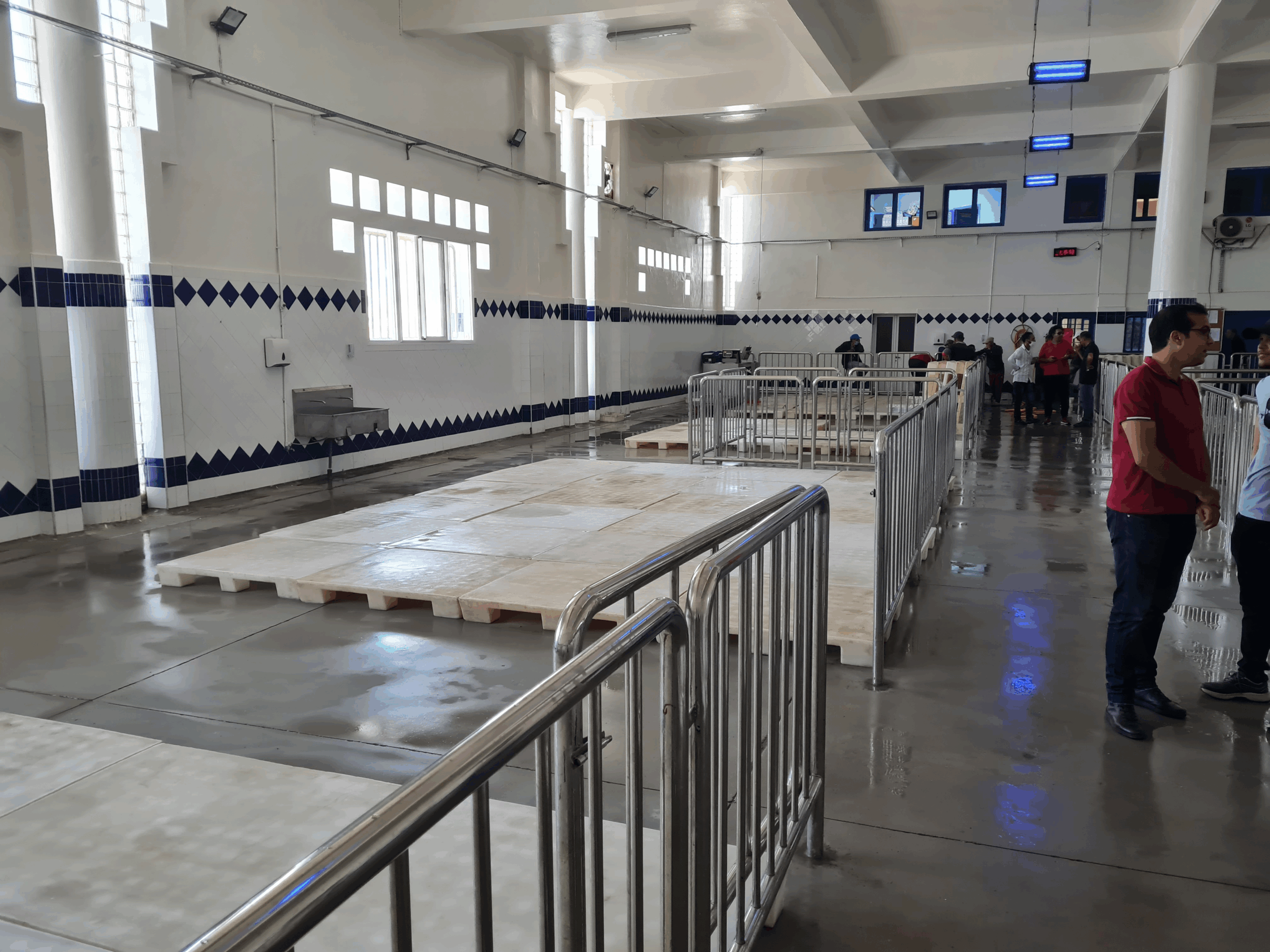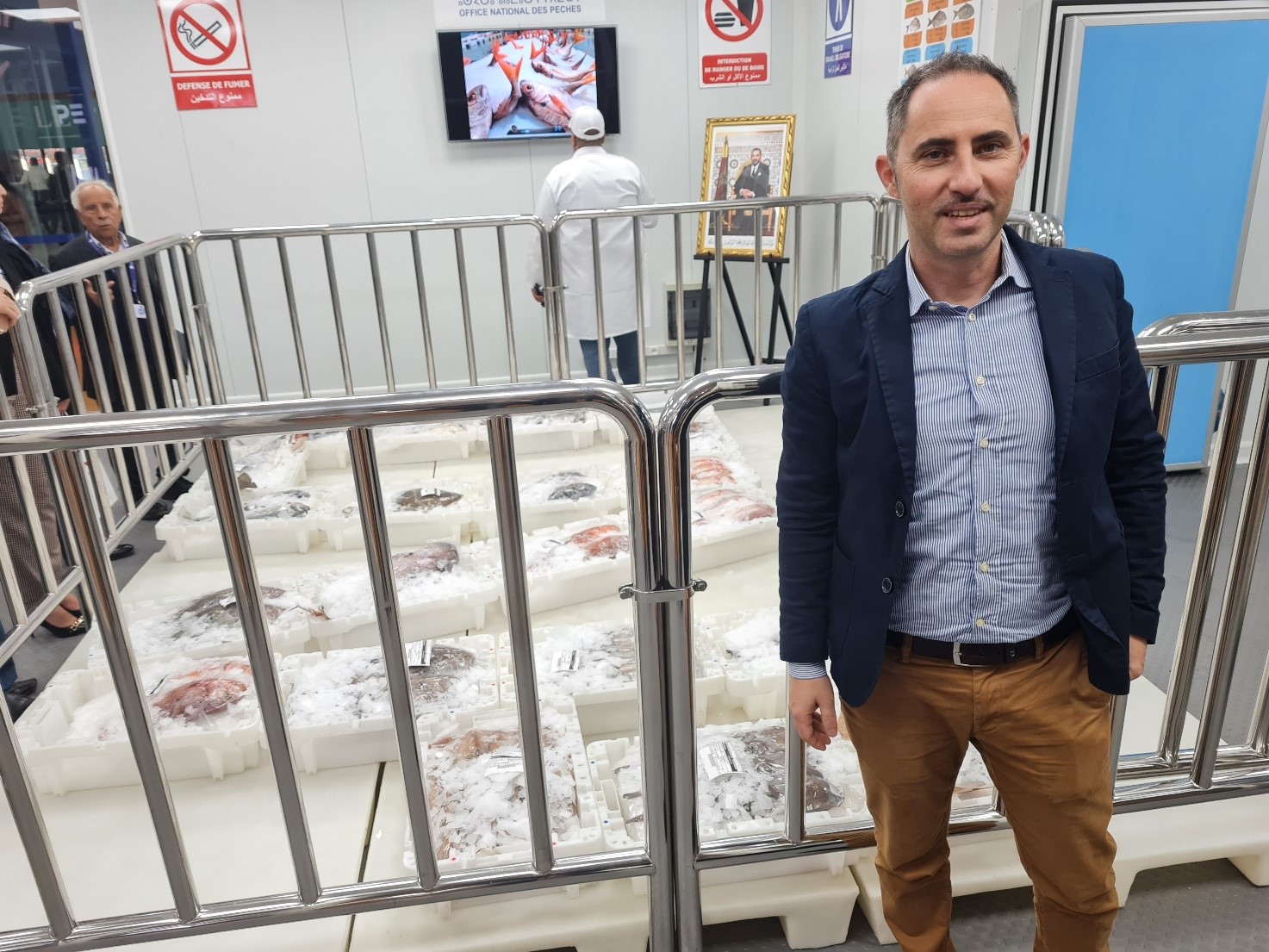Infrastructure requirements for First Sale Fishery Market FSFM – Part 4 – The FSFM plays a crucial role in the seafood supply chain, serving as the primary hub where freshly landed fish is introduced into the market. Ensuring an efficient and well-structured FSFM requires careful planning of its infrastructure to meet the needs of various stakeholders, including fishers, buyers, and regulatory bodies.
Infrastructure specification
The design concept project will be the responsibility of specialized architects and construction engineers. It is important that the infrastructure is appropriately dimensioned for the quantity of throughput and the requirements of the market users. Every fish market has its own characteristics and requirements that provide unique design for each one of them with specific national rules and internal regulations. The FSFM structure can be compared to any industrial building with its technical characteristics and must follow all the regulations as discussed in detail in the FSFM concept.
There is a wide range of potential market facilities that may be required, depending on local specific needs. These include:
ADMINISTRATIVE |
OPERATIONAL |
| Market offices and archives (i.e., committee, president and clerks) | Auction hall(s) |
| Arbitration board office | Large/Small scale auction space |
| Commissioner offices | Positive and negative cold storage (size according to need) |
| Social facilities (i.e., clock room, dining room, bathroom, shower, lockers) separate for internal staff and other staff (i.e., traders, fishermen) | Street networking and control in/out (including gate access control) |
| Public bathroom and showers | Ice production and storage (block or flake) |
| CA inspection facilities | Truck parking and disinfection/cleaning area |
| Middle man/woman offices, could include cold storage | Laboratories (CA and market) |
| First aid/health center | Market warehouse |
| Auxiliary | Market workshop |
| Pedestrian networking and control in/out (including “tornello” one way system) | Car/Truck parking outside/inside (only for authorized persons) |
| Technical rooms (i.e., water, electricity, generators, communication, counters) | Fish processing room |
| Water network: network, tank, water disinfection facilities, hand free water basin, hose reel | Crate/Pallet washing and storage |
| Wastewater network: drainage system, network, septic tanks, wastewater plant | Packaging room |
| Waste network (collecting bins) | Hyper/Supermarket platforms |
| Electrical network (i.e., generator, network, lighting) | Weighing area (separate or in the auction area) |
| Security house | Loading/Unloading area (truck and boat) |
| Handicap ramps and facilities | Associated Developments |
| Fire protection and related systems | Restaurant(s) and cafeteria(s) |
| Garden areas | Group of shops for the boat needs |
| Shaded landing place | Shops (not for fish) |
| Incinerator | Museum |
| Generator(s) shade | Other social buildings or stores |
| Jetty | Fish optimal landing facility |
The First sale fishery market can be coupled with many other activities from tourism, restaurant to seafood processing. It is common for market vicinities to be developed with several connected industries to satisfy the fishery chain. In the next lines some details the practical use of the facilities applied in three FSFM concepts with different requirements and space use. The FSFM can be close (but appropriately separated) to wholesale and retail markets and can make use some common facilities.

Construction description
The construction and operation of a FSFM is a highly specialized process that requires careful attention to the design, layout, structure, and hygiene specifications. Each area of the FSFM must be constructed with specific materials that ensure hygiene, durability, and efficiency, especially given the flow of large volumes of fresh fish and seafood products, which need to be handled in a sanitary environment. The above following the principle of the EU food safety packages. Below is an overview of the construction and hygiene requirements based on the FSFM construction table:
Design, Layout, and Structure
The FSFM is divided into several critical zones, each with its own specific design and construction requirements to maintain the flow of fishery products in a hygienic and efficient manner.
- Receiving/Landing Area: The area designed for unloading fishery products from landing boats or trucks must be spacious and located near the sea front. Ideally, the landing area is shaded and constructed with durable materials such as concrete and marine corrosion-resistant materials. The landing area should feature a column structure made of concrete, with walls and revolving doors to control the flow of personnel and fishery products. This ensures a one-way system for the products to flow from the receiving area to the auction area, avoiding contamination.
- Auction/Market Area: This is where the fishery products are prepared and made ready for auction. It must be located immediately behind the receiving area to maintain the flow of materials. The structure should be equipped with a smooth, impervious, and cleanable floor, reinforced with mosaic systems and proper drainage. The auction area features a central elevated platform for pallet storage and ventilation systems like windows with mesh protection and ceiling fans. The building should also be equipped with revolving doors to maintain a controlled flow and avoid cross-contamination.
- Internal Logistics and Hygiene Systems: The movement of fishery products between areas must be hygienic, facilitated by standard pallets, crates, and forklifts made of anti-corrosive materials. Pallet washing and disinfecting areas are vital for ensuring that products remain uncontaminated during transport.
Hygiene Recommendations and Specifications
The FSFM must adhere to strict hygiene standards to prevent contamination of seafood. All surfaces, including walls, ceilings, and floors, must be smooth, impervious, and easy to clean and disinfect. Water used for washing must be potable and meet EU regulations for water quality, including chlorination and temperature control.
- Materials: All construction materials used must be impervious to water and resistant to marine corrosion. Stainless steel, reinforced plastic, and concrete are commonly used for surfaces, while doors, especially in areas prone to contact with seawater, must be made from marine-grade materials to withstand the harsh environment. Floors should be waterproof, shock-resistant, and non-porous to prevent bacterial growth.
- Water and Waste Systems: A robust water system is essential for both personnel hygiene and cleaning of the fishery products. High-pressure hot water systems, along with hand-free water basins, should be available throughout the facility. Wastewater management is another critical aspect, with separate lines for “black” and “white” water to prevent contamination. Special care should be taken to ensure all drainage points are cleanable and that there are no water stagnation zones.
- Ice Production and Storage: Ice is crucial for maintaining the freshness of fishery products. The FSFM should have an ice production system capable of generating both block and flake ice, stored in sanitary conditions. Ice transport trolleys and bins should be made from stainless steel or food-grade plastic to ensure they do not contaminate the ice.

Material and Construction Durability
Given the demanding nature of the fishery market environment, construction materials must meet high standards of durability. For instance, the floors (the must solicited part of the FSFM) in receiving, auction, and docking areas must be reinforced with mesh and have a smooth, slip-resistant surface. The roof structure must be corrosion-resistant, particularly in areas exposed to saltwater.
Waste Management and Facilities
Proper waste disposal systems must be in place, including separate bins for organic waste, plastics, and other recyclables. Special care is taken to ensure that waste collection areas are kept away from food handling areas to avoid contamination. The construction of these areas includes smooth, easy-to-clean surfaces with appropriate drainage.
Personnel and Safety Facilities
The FSFM should provide hygienic facilities for staff, including toilets, showers, and laundry areas, located away from sensitive areas to avoid cross-contamination. The number and type of facilities must meet local regulations, with special provisions for workers’ changing areas and lockers.The construction of a First Sale Fishery Market involves careful planning and adherence to stringent hygiene standards to ensure the safe handling of fishery products. Each component of the FSFM, from the receiving and auction areas to waste disposal and personnel facilities, requires careful selection of materials that can withstand the marine environment and facilitate efficient and hygienic operations. These considerations are vital to maintaining food safety, ensuring product quality, and complying with regulatory requirements for fishery markets.
FSFM construction hygienic facilities
The hygienic requirements for the construction of fishery facilities, such as the landing site, auction/market areas, and associated structures, are crucial for maintaining the highest standards of cleanliness and safety, particularly in environments exposed to harsh marine conditions. These facilities must be designed with materials and layouts that facilitate the safe and hygienic handling of fishery products.
Walls in these facilities must be washable, cleanable, and disinfectable. To ensure hygiene, the walls should have no gaps between partitions, preventing the buildup of dirt and pathogens. The surface of the walls should be smooth, impervious, and easy to clean. The light colour of the walls aids in the easy detection of dirt, helping staff to maintain cleanliness. Special attention is given to the corners, where the wall meets the floor or other walls, which are “ready-made” to facilitate cleaning and avoid dirt accumulation in hard-to-reach areas.
Floors in these spaces also need to be washable and disinfectable, with surfaces designed to withstand the harsh conditions of constant cleaning and the corrosive effects of marine environments. Floors are constructed with a slight slope to facilitate the drainage of water, preventing water stagnation and ensuring proper effluent flow into drainage channels. Gully traps are installed at key points to further support drainage. The material and construction of the floor must withstand heavy loads from equipment and personnel without cracking, and they should not absorb liquids, making them resistant to contamination.
Mosaic preparation for floors is typically achieved through a multi-layer system. The bottom layer consists of medium-sized stones mixed with pozzolanic materials, followed by a second layer of concrete mixed with smaller stones and reinforced with mesh. The final layer includes fine stone dust, applied to reduce porosity and improve surface durability. Additionally, additives may be used to increase the elasticity of the structure, ensuring longevity and resistance to wear from daily use.
Ceilings are another critical component in maintaining hygiene. They must have a smooth, cleanable surface and are often painted in light colours to make it easier to spot dirt or debris. The framework of the ceiling should be hidden from view to prevent the accumulation of dust or other contaminants. Ceilings are also insulated to prevent condensation, which could create a breeding ground for bacteria and mold.
Drainage is another key element of hygiene in these facilities. Floors are sloped to direct effluent to drainage channels, which are wide, half-round, and equipped with removable covers for easy cleaning. Manholes and siphons are strategically placed to ensure proper drainage. The drainage system must be capable of handling peak demand, with all plumbing and drainage channels designed to prevent unnecessary water migration, ensuring that no water remains stagnant in any part of the facility.
Doors must meet strict requirements to prevent contamination. Personnel entrances and exits are separate from equipment passageways to reduce the risk of cross-contamination. Doors are designed with smooth, non-absorbent surfaces to facilitate cleaning, and the use of glass doors is strictly prohibited due to the risk of breakage. All doors must be fitted securely on all sides, including the floor, to prevent any gaps where dirt or moisture could accumulate.
Ventilation plays a crucial role in maintaining proper air quality within the facility. Adequate ventilation ensures that temperatures remain within a reasonable range and helps prevent excess humidity and condensation, which could promote the growth of mold, dust, and other contaminants. Mechanical ventilation must be designed to avoid contaminating the products with dust, soot, or other airborne particles, ensuring that the air movement within the facility is consistently controlled.
These construction and hygienic specifications are essential for creating a safe and efficient environment for the handling of fishery products. By focusing on easy-to-clean, non-absorbent materials, and ensuring proper drainage, ventilation, and structural integrity, these facilities can meet the highest standards of hygiene and operational efficiency.
List of FSFM equipment and consumables
The construction and operation of a fish market or auction facility (FSFM) necessitate a comprehensive set of equipment and consumables to maintain hygienic standards, support smooth operations, and ensure the safety and traceability of products. These materials range from basic hygiene equipment to specialized tools for sampling, testing, and handling fishery products.
Hygiene Equipment and Handwashing Facilities: Central to the hygiene standards of any FSFM are hand wash basins, which should be hands-free to minimize cross-contamination. These are supported by necessary accessories such as paper rolls for drying hands, liquid soap dispensers, and convenient waste disposal for used paper or wipes. Proper sanitation is critical, so sinks should be placed in accessible locations. For cleaning inspection equipment, a water heater is provided to ensure proper sanitization. Exterior and interior hoses, as well as small pressure washers, help maintain cleanliness around the facility, including on trucks and other surfaces.
Storage and Refrigeration: Proper storage conditions are essential to preserve the freshness and quality of fishery products. Refrigerators for fresh samples are maintained at 0-2°C, while low-temperature freezers, set to -20°C, are required for freezing samples. To ensure proper handling and traceability, sample containers and trays of various sizes are used, along with sealing tape, numbered seals, or labels that are clearly marked. These elements help maintain the integrity of samples and consignment data during transportation and analysis.
Sampling and Testing Equipment: A robust set of equipment is needed for the sampling and testing of products. Sampling tools such as saws, knives, and can openers be included for handling different types of fishery products. A dissecting kit is also essential for further analysis, including parasite examination, for which magnifying glasses or transparent tables are used. For sensory analysis, an SS inspection table with smooth, washable surfaces allows for easy cleaning and disinfection. Thermometers, both digital and with probes of different sizes, are crucial for monitoring temperature, and a pH meter is necessary for testing the quality of fresh products. Rapid testing kits for histamine in scombroids and sulphite testing for crustaceans ensure compliance with food safety standards. Sterile poly bags are also essential for sample storage and transport.
Personal Hygiene and Protective Gear: To maintain personal hygiene, workers are required to wear specific gear, such as white coats adorned with the FSFM logo, white boots, sterile sampling gloves, and hair-covering caps. Shoe covers further prevent the spread of contaminants. Proper attire helps maintain a hygienic work environment and ensures the safe handling of products.
Ice Production and Transport: To preserve the quality of the fish, small ice makers, capable of producing about 1 ton of ice per day, are essential. This ice is transported and stored in stainless steel or plastic trolleys to maintain its effectiveness. Ice is vital for keeping fish at the correct temperatures throughout the market or auction process.
Waste Disposal and Pest Control: Disposal of unused fish samples is handled by dedicated disposal bins, and an incinerator may be used for waste management. Pest control is also a major concern, and measures include window mesh to stop flying insects, ultraviolet high-voltage systems for fly control, and electronic rodent repellers. Classical mouse traps are also employed as part of a comprehensive approach to pest management.
First Aid and Emergency Supplies: A complete first aid kit is required to address potential accidents or injuries in the facility. In addition to basic medical supplies, it is important to have a set of cleaning equipment, both stainless steel and plastic, as well as cleaning consumables for floors, walls, ceilings, and other hygiene surfaces. Tools such as mops, disinfectants, and soap are needed for daily sanitation routines.
Traceability and Record Keeping: Traceability is a cornerstone of food safety in fishery markets. A traceability system is crucial for maintaining a record of every fish or seafood consignment, from harvest through to auction or sale. Label production machines, electronic or written data transfer systems, and appropriate forms allow for accurate tracking of all consignments. This system ensures that each product can be traced back to its origin, which is critical for food safety and regulatory compliance.
In conclusion, the equipment and consumables in a fish market or auction facility are critical for maintaining hygiene, ensuring product quality, and meeting regulatory standards. These items support the efficient operation of the facility, from proper storage and refrigeration to thorough testing and traceability of the products. Hygiene and safety are paramount, making these tools and supplies indispensable to the functioning of a high-standard FSFM.
Infrastructure requirements for First Sale Fishery Market FSFM – Part 4








Gostei do vosso trabalho